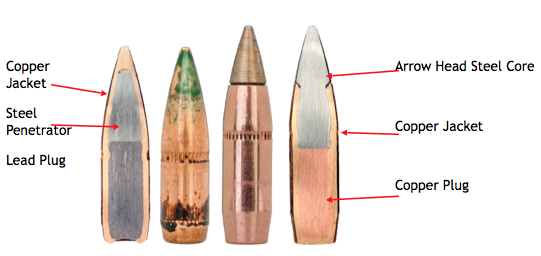Final result Figure 3. Maximum Effective Range.
Range Max possible miss distance 300 4.24 inches 200 2.02 inches 250 3.03 inches 248.5 3.00 inches Table 3. Iterating to find MER
So the accuracy MER condition is satisfied at a range of 248.5 yards. At this range, the 80-grain bullet retains 2231 fps (shot #3 conditions), which yields 883 ft-lbs of kinetic energy, thereby satisfying the established 500 ft-lbs MER lethality condition. If the bullet had less than the required energy, the MER would be dictated by decreasing the range until the 500 ft-lbs is satisfied, since the accuracy criteria was already met.
At the beginning of this article, I promised a component breakdown of the effects of each field variable on the trajectory. Table 4 shows the influence of each of the field variables on the original 300-yard target for shot #3.
Results Analysis
Contribution to total miss distance Shot #3 at 300 Yards Field variable Elev. Wind. Wind speed, Average 5 mph (+2mph error) -1.018” 2.51” Shooting direction, West (Coriolis acceleration) -0.23” 0” Muzzle Velocity, 2990 fps (-10 fps error) -0.16” 0” Air Density, Standard: 0.002378 Sl/ft3 (+5% = 0.002497 Sl/ft3) -0.29” 0” Other “6 degree of freedom” effects Gyroscopic drift 0” 0.40” Coriolis acceleration N/A 0.13” Total: -1.68” 3.04” Table 4. Miss distance component build up. The totals match those listed in Table 2 for shot #3.
The MER for our system is found to be 248.5 yards. So what? What can that information be used for? I mean, everything’s been based on assumptions, and the results are only valid for one particular combination of assumptions, so of what use is the answer “248.5 yards”, really? There are 2 basic ways that the preceding analysis can be applied.
8 The vertical component of the wind deflection is due to aerodynamic jump.
Range Max possible miss distance 300 4.24 inches 200 2.02 inches 250 3.03 inches 248.5 3.00 inches Table 3. Iterating to find MER
So the accuracy MER condition is satisfied at a range of 248.5 yards. At this range, the 80-grain bullet retains 2231 fps (shot #3 conditions), which yields 883 ft-lbs of kinetic energy, thereby satisfying the established 500 ft-lbs MER lethality condition. If the bullet had less than the required energy, the MER would be dictated by decreasing the range until the 500 ft-lbs is satisfied, since the accuracy criteria was already met.
At the beginning of this article, I promised a component breakdown of the effects of each field variable on the trajectory. Table 4 shows the influence of each of the field variables on the original 300-yard target for shot #3.
Results Analysis
Contribution to total miss distance Shot #3 at 300 Yards Field variable Elev. Wind. Wind speed, Average 5 mph (+2mph error) -1.018” 2.51” Shooting direction, West (Coriolis acceleration) -0.23” 0” Muzzle Velocity, 2990 fps (-10 fps error) -0.16” 0” Air Density, Standard: 0.002378 Sl/ft3 (+5% = 0.002497 Sl/ft3) -0.29” 0” Other “6 degree of freedom” effects Gyroscopic drift 0” 0.40” Coriolis acceleration N/A 0.13” Total: -1.68” 3.04” Table 4. Miss distance component build up. The totals match those listed in Table 2 for shot #3.
The MER for our system is found to be 248.5 yards. So what? What can that information be used for? I mean, everything’s been based on assumptions, and the results are only valid for one particular combination of assumptions, so of what use is the answer “248.5 yards”, really? There are 2 basic ways that the preceding analysis can be applied.
8 The vertical component of the wind deflection is due to aerodynamic jump.




Comment